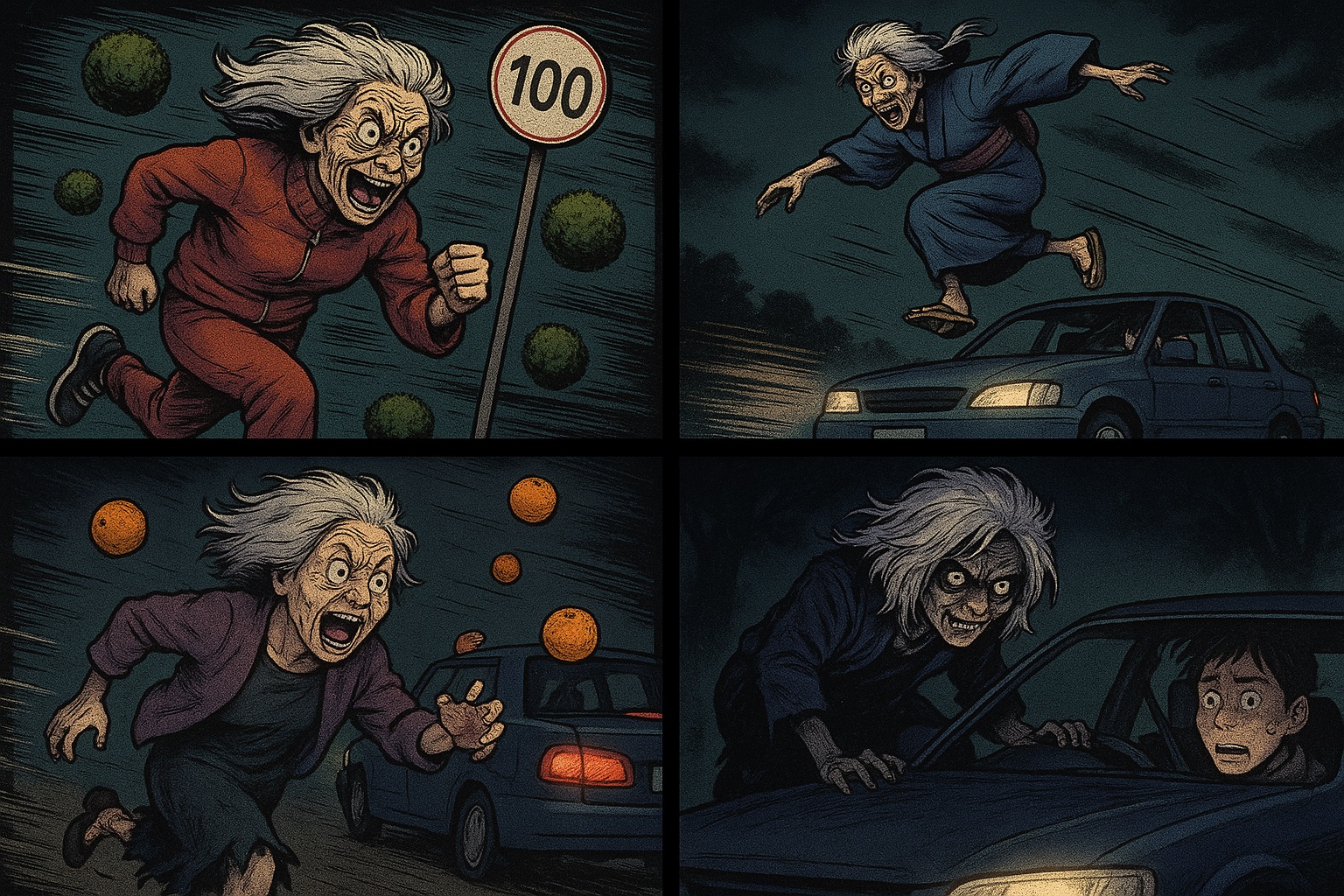Turbo Granny: The Definitive Guide to Japan's High-Speed Highway Hag
Turbo Granny: The Definitive Guide to Japan’s High-Speed Highway Hag

Imagine you’re driving down a dark, winding mountain road in Japan late at night. Suddenly, you hear a frantic tapping on your passenger-side window. You glance over and see her: a wrinkled old woman, her white hair flying in the wind, keeping pace with your car at over 100 km/h. She grins, her eyes wide with manic energy.
This is the terrifying encounter with Turbo Granny (Tābo Bāchan), one of Japan’s most bizarre and enduring modern urban legends. Part horrifying specter, part absurd punchline, she is a uniquely Japanese monster born from the fusion of ancient folklore and the anxieties of the automotive age.
This is the definitive guide to the high-speed hag, from her mysterious origins in the 1990s to her modern-day fame in manga and anime.
The Legend: The Ghost in the Fast Lane
The legend of Turbo Granny, which began to spread among Japanese schoolchildren in the late 1980s and early 1990s, has many variations, but the core elements remain chillingly consistent.
・The Setting: The encounter almost always happens at night, on a remote mountain pass (tōge), a dark tunnel, or a lonely stretch of highway. The Rokkō mountain range near Kobe is considered her most famous haunting ground.
・The Encounter: A driver, often speeding, is startled to find an old woman running alongside their vehicle at impossible speeds—anywhere from 100 to 140 km/h (60-85 mph). She may tap on the window, stare intently at the driver, or simply run alongside them with a terrifying grin.
・The Consequence: The outcome of the encounter varies. In some versions, if she overtakes you, you are doomed to die in a fatal crash. In others, simply seeing her is a bad omen. In the most surreal versions, she is simply a bizarre, fleeting vision that leaves the driver questioning their sanity.
Unlike many Japanese ghosts (yūrei), Turbo Granny is not a sorrowful, stationary spirit. She is aggressive, athletic, and unnervingly fast—a supernatural predator for the modern age.

The Origins: A Fusion of Ancient Fears and Modern Anxieties
Turbo Granny is not an ancient yokai, but her conceptual DNA can be traced back through centuries of Japanese folklore.
The Modern Boogeyman (1990s): The legend as we know it today solidified in the 1990s, spreading through word-of-mouth and magazine submissions, not the internet. Unlike later legends born on forums like 2channel, Turbo Granny is a product of Japan’s pre-digital “occult boom.”
The Yamauba Connection: Folklorists connect her to the Yamauba (Mountain Hag), a classic yokai from Japanese folklore. The Yamauba is a terrifying old woman who lives deep in the mountains and is known for her incredible speed, often chasing down lost travelers to devour them. Turbo Granny can be seen as a modern, asphalt-bound evolution of this ancient mountain monster.
The Ubasute Legacy: Some researchers also link her to the dark legends of Ubasute (“abandoning an old woman”), a supposed historical practice of leaving elderly relatives to die in the mountains during times of famine. Turbo Granny, in this interpretation, could be the vengeful spirit of an abandoned elder, her rage fueling her supernatural speed.
A Warning for the Automotive Age: Social analysts suggest the legend is a direct response to Japan’s motorization. As cars became faster and highways more common, a new kind of monster was needed—one that could challenge the speed of modern technology. Turbo Granny is a folkloric speed trap, a supernatural warning against reckless driving.
The Bizarre Variations: From Turbo Granny to Tangerine Hag
One of the most fascinating aspects of the legend is its numerous regional variations, each with its own bizarre twist.
100-Kilo Bāchan (Hokkaido): A version that runs at exactly 100 km/h. She can supposedly be repelled by throwing marimo (moss balls, a local specialty) at her.
Jumping Bāchan (Shizuoka/Aichi): This granny, dressed in a traditional kimono and geta sandals, doesn’t run—she takes 4-meter-high leaps to keep up with cars.
Mikan Bāchan (Tangerine Granny): A strange version where an old woman chases you while throwing tangerines.
Bonnet Bāchan (Hood Granny): In this terrifying variant, the granny doesn’t run alongside the car; she jumps directly onto the hood and stares at the driver through the windshield.
These variations, often humorous and absurd, highlight the playful nature of urban legends, as communities add their own local flavor to the core story.

Turbo Granny in Pop Culture: The Dandadan Phenomenon
For decades, Turbo Granny was a well-known but relatively niche figure in the pantheon of Japanese urban legends. That all changed with the 2021 manga and subsequent anime series, Dandadan.
In Dandadan, “Turbo Granny” is the first major antagonist the protagonists face. She is portrayed as a terrifyingly powerful and relentless yokai who haunts a tunnel and demands a rather shocking tribute from her male victims. The manga’s unique blend of high-octane action, horror, and comedy brought Turbo Granny to a massive new international audience. Thanks to Dandadan, a new generation of fans worldwide has been introduced to the legend of the high-speed hag.
The Search for Evidence: Fact or Fiction?
Despite her fame, there is no credible evidence that Turbo Granny exists. The “photos” and “videos” that circulate online are universally acknowledged as fakes, often created as part of marketing campaigns or television hoaxes. In 2017, a viral video purporting to have “captured” Turbo Granny on a mountain road was later revealed to be a clever ad for a WiMAX internet service.
Scientifically, it is impossible for a human, let alone an elderly woman, to run at highway speeds. Sightings are most likely the product of tricks of the light, reflections on a car window, driver fatigue, or simply the power of suggestion after hearing the story.
Turbo Granny is a ghost story, not a biological anomaly. But her legend endures because she represents a perfect and uniquely Japanese blend of horror and humor. She is a creature born from the collision of the ancient and the modern, the supernatural and the mechanical. She is a reminder that no matter how fast our technology becomes, our oldest fears will always find a way to keep up.
References
Wikipedia (Japanese) – Urban Legends
Wikipedia (Japanese) – Internet Meme
NAVER Matome (Archived) – Origins and Spread of Turbo Granny
…and other sources.
The Terror Doesn’t End Here
The chilling tale of Turbo Granny is just one piece of a much larger, darker puzzle. Our central hub features in-depth guides to all of Japan’s most iconic modern nightmares.
※ Unauthorized reproduction, video creation, and uploading of this article's content to YouTube, blogs, or other platforms is strictly prohibited.
Related Articles
Popular Series
This is the page for Turbo Granny: The Definitive Guide to Japan’s High-Speed Highway Hag. Find the latest news about JapaneseHorror, Folklore, Yokai, TurboGranny and more on TOCANA - the paranormal news media that stimulates your curiosity
Urban Legends Latest Articles
The Definitive Guide to Japan's Scariest Urban Legends: From Kuchisake-Onna to Kisaragi Station
2025.10.20 23:00 Urban LegendsKunekune: The Definitive Guide to Japan's Terrifying, Twisting Field Monster
2025.10.19 23:00 Urban LegendsNNN Special Broadcast: The Definitive Guide to Japan's Lost, Lethal TV Broadcast
2025.10.14 23:00 Urban Legends






